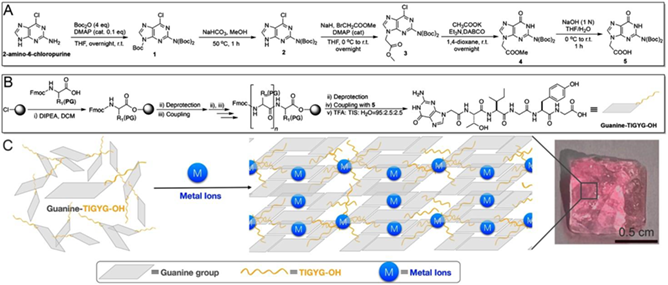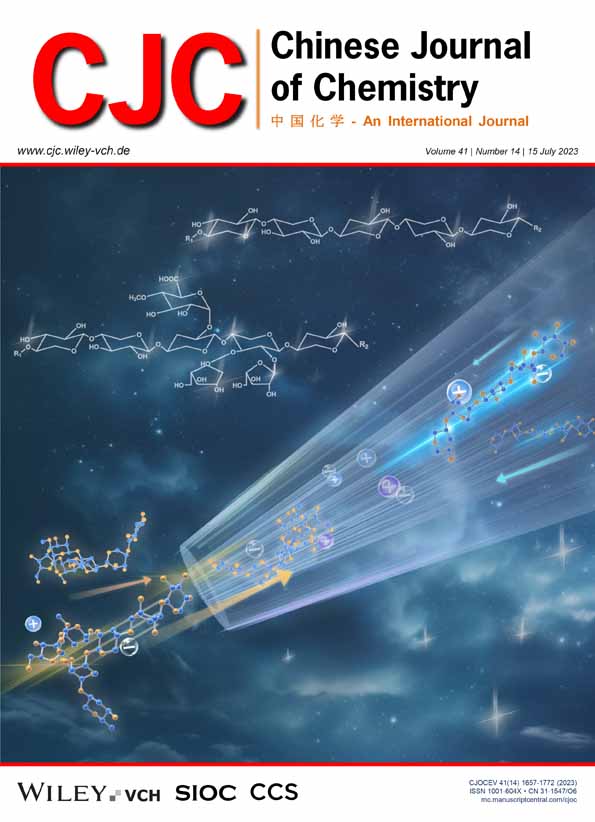Hierarchical Self-assembly of G-Quadruplexes Based Hydrogel Consisting of Guanine and Peptide Epitope†
Hongyue Zhang
Department of Chemistry, Zhejiang University, Hangzhou, Zhejiang, 310027 China
Key Laboratory of Precise Synthesis of Functional Molecules of Zhejiang Province, Department of Chemistry, School of Science, Westlake University; Institute of Natural Sciences, Westlake Institute for Advanced Study, No. 600 Dunyu Road, Hangzhou, Zhejiang, 310024 China
Search for more papers by this authorXuejiao Yang
Key Laboratory of Precise Synthesis of Functional Molecules of Zhejiang Province, Department of Chemistry, School of Science, Westlake University; Institute of Natural Sciences, Westlake Institute for Advanced Study, No. 600 Dunyu Road, Hangzhou, Zhejiang, 310024 China
Search for more papers by this authorJuan Liang
Key Laboratory of Precise Synthesis of Functional Molecules of Zhejiang Province, Department of Chemistry, School of Science, Westlake University; Institute of Natural Sciences, Westlake Institute for Advanced Study, No. 600 Dunyu Road, Hangzhou, Zhejiang, 310024 China
Search for more papers by this authorKaihua Chen
Key Laboratory of Precise Synthesis of Functional Molecules of Zhejiang Province, Department of Chemistry, School of Science, Westlake University; Institute of Natural Sciences, Westlake Institute for Advanced Study, No. 600 Dunyu Road, Hangzhou, Zhejiang, 310024 China
Search for more papers by this authorCorresponding Author
Huaimin Wang
Department of Chemistry, Zhejiang University, Hangzhou, Zhejiang, 310027 China
Key Laboratory of Precise Synthesis of Functional Molecules of Zhejiang Province, Department of Chemistry, School of Science, Westlake University; Institute of Natural Sciences, Westlake Institute for Advanced Study, No. 600 Dunyu Road, Hangzhou, Zhejiang, 310024 China
E-mail: [email protected]Search for more papers by this authorHongyue Zhang
Department of Chemistry, Zhejiang University, Hangzhou, Zhejiang, 310027 China
Key Laboratory of Precise Synthesis of Functional Molecules of Zhejiang Province, Department of Chemistry, School of Science, Westlake University; Institute of Natural Sciences, Westlake Institute for Advanced Study, No. 600 Dunyu Road, Hangzhou, Zhejiang, 310024 China
Search for more papers by this authorXuejiao Yang
Key Laboratory of Precise Synthesis of Functional Molecules of Zhejiang Province, Department of Chemistry, School of Science, Westlake University; Institute of Natural Sciences, Westlake Institute for Advanced Study, No. 600 Dunyu Road, Hangzhou, Zhejiang, 310024 China
Search for more papers by this authorJuan Liang
Key Laboratory of Precise Synthesis of Functional Molecules of Zhejiang Province, Department of Chemistry, School of Science, Westlake University; Institute of Natural Sciences, Westlake Institute for Advanced Study, No. 600 Dunyu Road, Hangzhou, Zhejiang, 310024 China
Search for more papers by this authorKaihua Chen
Key Laboratory of Precise Synthesis of Functional Molecules of Zhejiang Province, Department of Chemistry, School of Science, Westlake University; Institute of Natural Sciences, Westlake Institute for Advanced Study, No. 600 Dunyu Road, Hangzhou, Zhejiang, 310024 China
Search for more papers by this authorCorresponding Author
Huaimin Wang
Department of Chemistry, Zhejiang University, Hangzhou, Zhejiang, 310027 China
Key Laboratory of Precise Synthesis of Functional Molecules of Zhejiang Province, Department of Chemistry, School of Science, Westlake University; Institute of Natural Sciences, Westlake Institute for Advanced Study, No. 600 Dunyu Road, Hangzhou, Zhejiang, 310024 China
E-mail: [email protected]Search for more papers by this authorDedicated to the Special Issue of Hydrogels.
Comprehensive Summary
Guanosine-based hydrogels have attracted considerable attention because of their simplicity and easy preparation. However, the sugar moiety limits its further applications because of the necessity of sugar in the hydrogel formation. This work reports a G-quadruplexes-based hydrogel consisting of guanine and peptide epitope to form a supramolecular hydrogel in the presence of metal cations. Using the metal ion-responsive peptide epitope from the ion channel to replace sugar motif at N9 position of guanosine results in a novel nucleopeptide. The results show that the gelation time, the diameter of nanofibers, the anisotropic property, and the mechanical property of the hydrogel can be simply controlled using metal cations. The magnesium and calcium ions direct the alignment of nanofibers to form anisotropic nano-bundles. The mechanistic studies indicate the formation of G-quadruplexes in the hydrogel. Compared to the storage modulus of nucleopeptide without the metal cation, adding zinc ions results in an over three-order increase in mechanical properties. Cytotoxicity experiment indicates the good biocompatibility of our hydrogel. Moreover, we demonstrate that the guanine-capped peptide could release STING agonist in a controlled manner. This work illustrates a simple way to modulate the property of the nucleopeptide hydrogel to develop soft materials.
Supporting Information
| Filename | Description |
|---|---|
| cjoc202300039-sup-0001-supinfo.pdfPDF document, 24.7 MB |
Appendix S1: Supporting Information |
Please note: The publisher is not responsible for the content or functionality of any supporting information supplied by the authors. Any queries (other than missing content) should be directed to the corresponding author for the article.
References
- 1 Gao, Y.; Kuang, Y.; Guo, Z.-F.; Guo, Z.; Krauss, I. J.; Xu, B. Enzyme- Instructed Molecular Self-assembly Confers Nanofibers and a Supramolecular Hydrogel of Taxol Derivative. J. Am. Chem. Soc. 2009, 131, 13576–13577.
- 2 Du, X.; Zhou, J.; Shi, J.; Xu, B. Supramolecular Hydrogelators and Hydrogels: From Soft Matter to Molecular Biomaterials. Chem. Rev. 2015, 115, 13165–13307.
- 3 Li, J.; Mooney, D. J. Designing hydrogels for controlled drug delivery. Nat. Rev. Mater. 2016, 1, 16071.
- 4 Shi, Q.; Liu, H.; Tang, D.; Li, Y.; Li, X.; Xu, F. Bioactuators based on stimulus-responsive hydrogels and their emerging biomedical applications. NPG Asia Mater. 2019, 11, 64.
- 5 Ikeda, M.; Tanida, T.; Yoshii, T.; Kurotani, K.; Onogi, S.; Urayama, K.; Hamachi, I. Installing logic-gate responses to a variety of biological substances in supramolecular hydrogel–enzyme hybrids. Nat. Chem. 2014, 6, 511–518.
- 6 Zhao, Y.; Song, S.; Ren, X.; Zhang, J.; Lin, Q.; Zhao, Y. Supramolecular Adhesive Hydrogels for Tissue Engineering Applications. Chem. Rev. 2022, 122, 5604–5640.
- 7 Sun, B.; Tao, K.; Jia, Y.; Yan, X.; Zou, Q.; Gazit, E.; Li, J. Photoactive properties of supramolecular assembled short peptides. Chem. Soc. Rev. 2019, 48, 4387–4400.
- 8 Kim, J. H.; Lim, S. Y.; Nam, D. H.; Ryu, J.; Ku, S. H.; Park, C. B. Self-assembled, photoluminescent peptide hydrogel as a versatile platform for enzyme-based optical biosensors. Biosens. Bioelectron. 2011, 26, 1860–1865.
- 9 Xiao, M.; Gao, L.; Chandrasekaran, A. R.; Zhao, J.; Tang, Q.; Qu, Z.; Wang, F.; Li, L.; Yang, Y.; Zhang, X.; Wan, Y.; Pei, H. Bio-functional G-molecular hydrogels for accelerated wound healing. Mater. Sci. Eng. C 2019, 105, 110067.
- 10 Zhou, Y.; Qiu, P.; Yao, D.; Song, Y.; Zhu, Y.; Pan, H.; Wu, J.; Zhang, J. A crosslinked colloidal network of peptide/nucleic base amphiphiles for targeted cancer cell encapsulation. Chem. Sci. 2021, 12, 10063–10069.
- 11 Sonamuthu, J.; Cai, Y.; Liu, H.; Kasim, M. S. M.; Vasanthakumar, V. R.; Pandi, B.; Wang, H.; Yao, J. MMP-9 responsive dipeptide-tempted natural protein hydrogel-based wound dressings for accelerated healing action of infected diabetic wound. Int. J. Biol. Macromol. 2020, 153, 1058–1069.
- 12 Wu, J.; Li, P.; Dong, C.; Jiang, H.; Xue, B.; Gao, X.; Qin, M.; Wang, W.; Chen, B.; Cao, Y. Rationally designed synthetic protein hydrogels with predictable mechanical properties. Nat. Commun. 2018, 9, 1–11.
- 13 Wang, Y.; Jiang, Z.; Xu, W.; Yang, Y.; Zhuang, X.; Ding, J.; Chen, X. Chiral Polypeptide Thermogels Induce Controlled Inflammatory Response as Potential Immunoadjuvants. ACS Appl. Mater. Interfaces 2019, 11, 8725–8730.
- 14 Luo, Z.; Wu, Q.; Yang, C.; Wang, H.; He, T.; Wang, Y.; Wang, Z.; Chen, H.; Li, X.; Gong, C.; Yang, Z. A Powerful CD8+ T-Cell Stimulating D-Tetra-Peptide Hydrogel as a Very Promising Vaccine Adjuvant. Adv. Mater. 2017, 29, 1601776.
- 15 Wang, H.; Luo, Z.; Wang, Y.; He, T.; Yang, C.; Ren, C.; Ma, L.; Gong, C.; Li, X.; Yang, Z. Enzyme-Catalyzed Formation of Supramolecular Hydrogels as Promising Vaccine Adjuvants. Adv. Funct. Mater. 2016, 26, 1822–1829.
- 16 Wang, F.; Su, H.; Xu, D.; Dai, W.; Zhang, W.; Wang, Z.; Anderson, C. F.; Zheng, M.; Oh, R.; Wan, F.; Cui, H. Tumour sensitization via the extended intratumoural release of a STING agonist and camptothecin from a self-assembled hydrogel. Nat. Biomed. Eng. 2020, 4, 1090–1101.
- 17 Gao, G.; Jiang, Y.-W.; Zhan, W.; Liu, X.; Tang, R.; Sun, X.; Deng, Y.; Xu, L.; Liang, G. Trident molecule with nanobrush–nanoparticle–nanofiber transition property spatially suppresses tumor metastasis. J. Am. Chem. Soc. 2022, 144, 11897–11910.
- 18 Feng, Z.; Wang, H.; Chen, X.; Xu, B. Self-assembling ability determines the activity of enzyme-instructed self-assembly for inhibiting cancer cells. J. Am. Chem. Soc. 2017, 139, 15377–15384.
- 19 Cai, Y.; Shen, H.; Zhan, J.; Lin, M.; Dai, L.; Ren, C.; Shi, Y.; Liu, J.; Gao, J.; Yang, Z. Supramolecular “Trojan Horse” for nuclear delivery of dual anticancer drugs. J. Am. Chem. Soc. 2017, 139, 2876–2879.
- 20 Pires, R. A.; Abul-Haija, Y. M.; Costa, D. S.; Novoa-Carballal, R.; Reis, R. L.; Ulijn, R. V.; Pashkuleva, I. Controlling cancer cell fate using localized biocatalytic self-assembly of an aromatic carbohydrate amphiphile. J. Am. Chem. Soc. 2015, 137, 576–579.
- 21 Roviello, G. N.; Benedetti, E.; Pedone, C.; Bucci, E. M. Nucleobase- containing peptides: an overview of their characteristic features and applications. Amino Acids 2010, 39, 45–57.
- 22 Hector, R. F.; Zimmer, B. L.; Pappagianis, D. Evaluation of nikkomycins X and Z in murine models of coccidioidomycosis, histoplasmosis, and blastomycosis. Antimicrob. Agents Chemother. 1990, 34, 587–93.
- 23 Shimizu, T.; Iwaura, R.; Masuda, M.; Hanada, T.; Yase, K. Internucleobase-interaction-directed self-assembly of nanofibers from homo- and heteroditopic 1,ω-nucleobase bolaamphiphiles. J. Am. Chem. Soc. 2001, 123, 5947–5955.
- 24 Li, X.; Kuang, Y.; Lin, H.-C.; Gao, Y.; Shi, J.; Xu, B. Supramolecular Nanofibers and Hydrogels of Nucleopeptides. Angew. Chem. Int. Ed. 2011, 50, 9365–9369.
- 25 Li, X.; Yi, K.; Shi, J.; Gao, Y.; Lin, H.-C.; Xu, B. Multifunctional, Biocompatible Supramolecular Hydrogelators Consist Only of Nucleobase, Amino Acid, and Glycoside. J. Am. Chem. Soc. 2011, 133, 17513–17518.
- 26 Baek, K.; Noblett, A. D.; Ren, P.; Suggs, L. J. Design and characterization of nucleopeptides for hydrogel self-assembly. ACS Appl. Bio Mater. 2019, 2, 2812–2821.
- 27 Noblett, A. D.; Baek, K.; Suggs, L. J. Controlling Nucleopeptide Hydrogel Self-Assembly and Formation for Cell-Culture Scaffold Applications. ACS Biomater. Sci. Eng. 2021, 7, 2605–2614.
- 28 Guschlbauer, W.; Chantot, J.-F.; Thiele, D. Four-stranded nucleic acid structures 25 years later: from guanosine gels to telomer DNA. J. Biomol. Struct. Dyn. 1990, 8, 491–511.
- 29 Kuang, Y.; Gao, Y.; Shi, J.; Lin, H.-C.; Xu, B. Supramolecular hydrogels based on the epitope of potassium ion channels. Chem. Commun. 2011, 47, 8772–8774.
- 30 D'Avanzo, N.; Pekhletski, R.; Backx, P. H. P-loop residues critical for selectivity in K channels fail to confer selectivity to rabbit HCN4 channels. PLoS One 2009, 4, e7712.
- 31 Seebohm, G.; Westenskow, P.; Lang, F.; Sanguinetti, M. C. Mutation of colocalized residues of the pore helix and transmembrane segments S5 and S6 disrupt deactivation and modify inactivation of KCNQ1 K+ channels. J. Physiol. 2005, 563, 359–368.
- 32 Wu, B.; Zhao, S.; Yang, X.; Zhou, L.; Ma, Y.; Zhang, H.; Li, W.; Wang, H. Biomimetic Heterodimerization of Tetrapeptides to Generate Liquid Crystalline Hydrogel in A Two-Component System. ACS Nano 2022, 16, 4126–4138.
- 33 Wang, F.; Su, H.; Xu, D.; Dai, W.; Zhang, W.; Wang, Z.; Anderson, C. F.; Zheng, M.; Oh, R.; Wan, F. Tumour sensitization via the extended intratumoural release of a STING agonist and camptothecin from a self-assembled hydrogel. Nat. Biomed. Eng. 2020, 4, 1090–1101.




